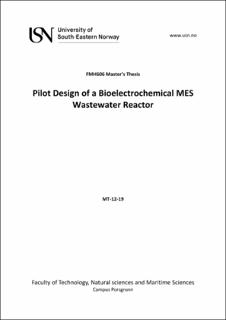| dc.description.abstract | The reject water of any wastewater treatment plant (WWTP) contains carbon dioxide
(CO2) and micro-organisms. The environmental biotechnology research group of the
University of South-Eastern Norway (USN) is trying to develop a sustainable pilot
reactor for reducing CO2 and upgrading biogas by implementing Microbial
Electrosynthesis (MES). The study of an MES reactor is the main purpose of the thesis.
MES method is capable of producing more energy-rich methane by reducing CO2. This
method needs to grow biofilm at the biocathode and supply of electricity. A
bioelectrochemical reactor is designed and needs to integrate into an existing AD biogas
process. A designed MES reactor should be economically feasible and efficient for
execution. In the design, dimensions, parameters, maintenance, safety, and selection of
material are discussed and drawn in 3D. The breakeven point is calculated in terms of
capital expenditure (CAPEX). The efficiency of the pilot design is compared with the
experimental reactor.
The pilot reactor is designed with SS 316 material for vessel and electrodes with a total
cost of 4.24 million NOK. The methane production rate is 119 m3
/day and the breakeven
point is about 8 years. These make this project feasible for commercial use. | en_US |
